Lots of these Li-Po battery packs on eBay, going for around £12 from various vendors:
Nice hand-sized battery pack, with a coax plug and socket on flying leads, and a handy little power switch and LED. Comes with a somewhat underspecced charger (350mA – so, around 20 hours to charge).
The battery specs seem too good to be true, though. 6800mAh at 12V? Nearly 7Ah at a fraction of the size of an old fashioned gel battery. Hmm.
Testing:
To test the battery capacity, I hooked it up to a little LCD telly via a Turnigy power analyser.
The TV takes about 0.3A, so it ought to run for about 20 hours. Ha! To start the test, I charged the battery fully with the supplied charger:
12.77V is a little high, but it’s straight off the charger; it’ll relax back to around 12.6V.
About 6 hours later, it was time to switch it off before the battery flattened itself permanently (10.8V is as low as you should go):
So. Not really 6.8Ah at all, more like a third of that. I think I know what they’ve done, though (assuming they aren’t just out and out dishonest): to create a nominally 12 volt battery, they’ve strung 3 cells together in series – but then they’ve mistakenly added the Ah capacities of the cells together. Connect 3 cells in series, you add the voltages, but Ah stays the same as a single cell; connect them in parallel instead, and you add the Ah up but the voltage stay the same as a single cell. They’ve mixed it up.
The headline, therefore: these battery packs only have a third of their marked capacity. Caveat emptor etc.
The upside (!) is that the little charger that comes with it takes half the time to charge it.
UPDATE: A kind commenter, Unferium, notes below that Li-Po cells can be safely discharged to about 3V per cell rather than the 3.6V I used, which does change the results slightly. The voltage drops off very fast from 10.8V down, so you only get an extra 0.25Ah out of the pack. I think the headline stands 🙂
Teardown:
Anyway, let’s see what’s inside. Note: Lithium batteries can explode or burst into flames if mishandled, or if they’re faulty. Do not take one apart unless you know what you’re doing, or you’re an idiot. Thankfully, I’m fully qualified in at least one of those categories.
First, off comes the outer blue shrink-wrap:
… revealing a stiff cardboard “case”. It comes apart easily to reveal:
The actual battery of cells is just the silver chunk; the dark strip on the left is just dense packing foam. Shame they couldn’t just make the whole pack a bit smaller instead – I can’t see what benefit that padding does given that it’s only on one side of the cells. Even if something bad happens to the battery and the cells start expanding, they’ll blow up like a pillow, not out sideways. Ho hum.
Let’s pull the cells out:
Yup, three Li-Po cells in series. Thankfully they’ve each got their own protection circuit (which disconnects the cells before they get overcharged, or so discharged they’re unsafe to charge again):
The 3 cells are extremely securely glued together, so don’t try pulling them apart. If the foil envelope around a cell is punctured, they give off a strangely fruity smell and need to be disposed of safely in a neighbour’s bin. (Not the nice neighbours, the ones on the other side)
In use:
Despite their misleading label, they’re still useful battery packs, particularly for Arduino / microcontroller use. 2.2Ah at 12V is still plenty of juice for some projects. Here’s a little wireless monitor I rustled up to monitor our solar panels:
It’s just an LCD, an Arduino and an nRF24L01+ radio module, all cable-tied to the battery:
Lasts for a couple of days between charges, and it’s surprisingly robust. Easy to recharge with the charger that came with the battery (albeit a bit slow).
Conclusion:
They’re not as good as they say they are, but they’re still handy.
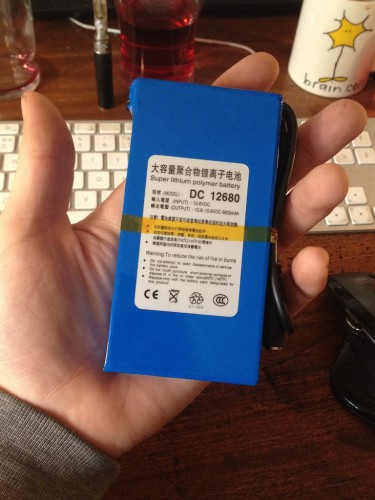

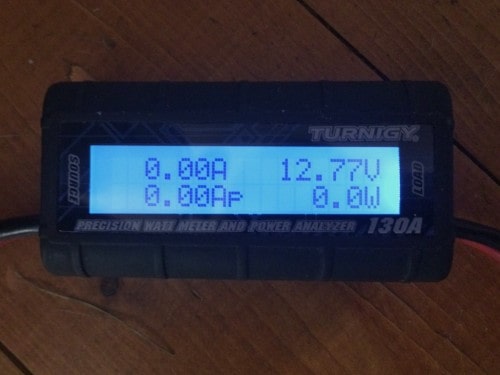
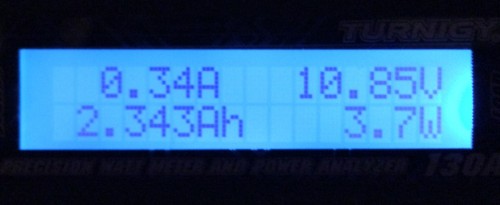
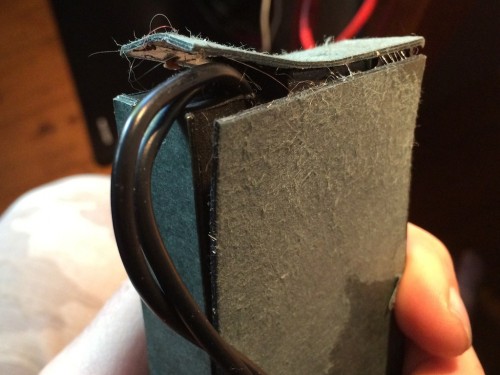
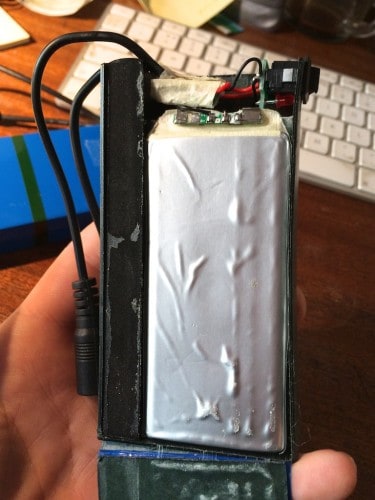
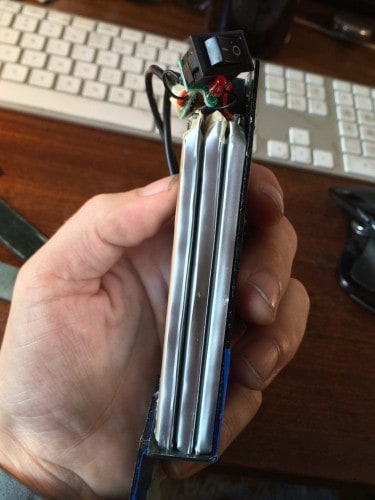
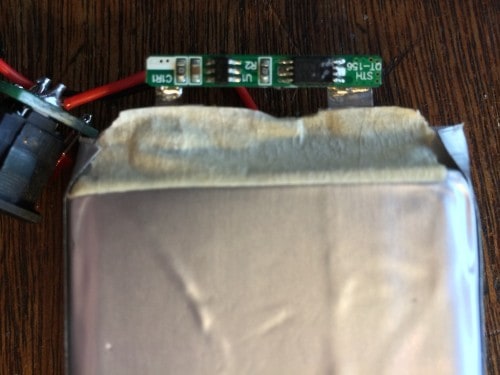
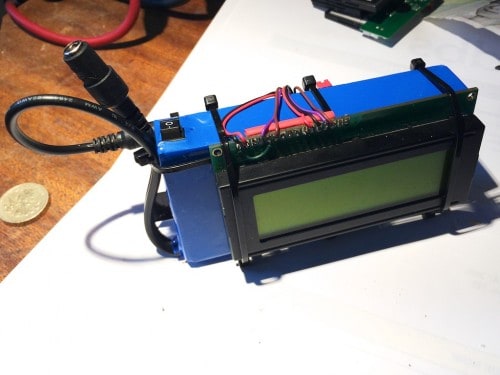
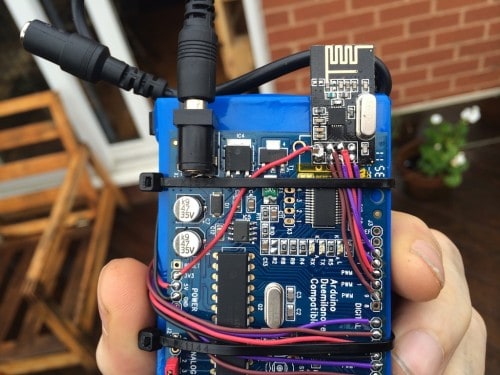
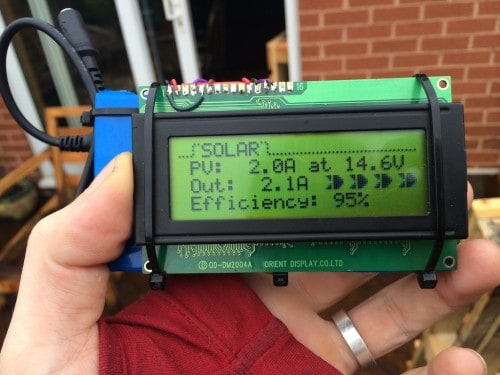
Link to store to buy?
Search eBay for “12V 6800” and you’ll find plenty of examples at a wide range of prices. Eg: http://tinyurl.com/qcr5tdk
That foam padding might not be for safety so much as for a alternate design the original manufacturer planned where the foam padding is taken out so a larger Li-Po battery packs can be put inside and they can sale their new higher capacity battery pack to their customers.
You could well be right, but from what I can see the higher capacity versions (9600mAh) seem to use a larger case as well.
Huh. My next two ideas on that foam were:
1. Perhaps they had plans for a larger charging circuit or such and the foam was just their as filler so they could maintain the same form factor with the next design.
2. The battery pack might have been intended to lay on its side (perhaps in a compartment?) with the foam cushioning the Li-Po packs against bumps/impacts.
Although, neither of those sound quite…….right.
Perhaps I’m just overthinking this.
You could be right. The way the whole thing’s constructed of sticky-backed card just feels so clunky and home-made. Guess they could have had a load of pre-cut bits already…
Thank you for a Teardown of these cheap packs. I originally jus thought – Nooo – that thing is going to set your house on fire! – But seeing that it employs a safety-circuit on each cell, it’s pretty much idiot-proof – i like that!
Is it just the pictures, or are the bottom of the cells not square ? It looks angled – This could indicate that the cells are made of scrap-materials (fits with the price)
The camera angle makes it look worse than it is, but yup, the cells sure aren’t square…
Hi,
Sorry about the long comment… Here goes:
It looks like you’ve only used half of the batteries’ total capacity:
10.8 / 3 = 3.6v – this is the nominal (expected) voltage.
Cut-off voltages depending on the load (as a guide):
1/4C – 3v per cell
1/2C – 3.15v per cell – sag to 9.1v total pack
1C – 3.2v per cell, The total voltage sag shouldn’t go lower than 9v Max,
Also cut off discharging if any cell reaches above 30*C (Just in case).
All learned from experience and research.
With the above as a guide, did you see any more capacity?
Stay safe though!
Hmm… might have to run the tests again. I know the little protection circuit will cut the batteries off at a certain point, but I never noted what voltage it was.
Thanks for the heads-up!
Well – I’ve done another test, this time in reverse: I discharged a battery as far as it would go (ie until the safety circuit cut the pack off). It hit a low of about 8.2V.
(Once the pack gets down to 10.8V the voltage falls off really fast – it’s certainly not linear.)
Then I hooked it up to the Power Analyser and charged it fully, keeping track of how much charge the battery would take – 2.6Ah, a little more than my result above, but not much.
I’ll amend the article. Thanks for the advice!
Thanks for the review.
Do you think that type of battery could power a motorcycle horn that sucks 1.5A?
http://cgi.ebay.fr/ws/eBayISAPI.dll?ViewItem&rd=1&item=331101208358
Do you know if you can charge these and use them at the same time?
Can you charge them by just attaching ANY 12v power source to them (i.e. the charge circuit is in the battery) or does it have to be the supplied charger?
Thanks
Thanks for the great tear down and info. I had purchased one of these but was concerned about using and charging it because of the lack of available info. Nice to know the protection circuit is real. I was hoping you’d be able to answer a question for me. I want to use these inside a portable stereo and will need to leave the battery switch in the on position all the time. My question relates to the led. Do you think having this led on all the time could potentially drain the battery to a dangerous or damaging level if it is not used for a while? Or would the protection circuit kick in at that level and shut off the led too? Any insight would be appreciated.
Because of the LED, the battery loses about 0.07V per day, so a fully charged battery should last about 25 days before reaching 10.8V (basically fully discharged). I charge mine once a week to be safe.
I bought this battery. I used it once. Worked great. I went to recharge it, and it is taking forever! How long does it take to charge? Mine has been charging for close to 12 hours. What is the best practice for charging it?
I have had a number stop charging just after I bought them! Is there any way to repair them? Is there a built in charge controller as with other batteries? Do they switch off?
Hi, great tear down! I found this really useful as I have been looking at these for a while and was slightly dubious of the lack of information/reviews of them.
I’m making a portable music system and was contemplating buying the 9800mah version purely based on the price but in light of your tear down I’m thinking I’ll go for three and wire them in parallel to regain the capacity and they should still work out around half the price of the nearest competitor!
Could you possible give me some dimensions of just the three cells and circuitry without the packaging please?
Cheers
Nice review thanks
Can you weigh the battery and post the weight.
These batteries are absolute trash, avoid at all costs. I disassembled the 3000mah li-ion version, and underneath the blue plastic on the outside, is a CARDBOARD BOX wrapped in tape, which contains 3x QMobile (made in Pakistan) CELL PHONE batteries at 3.7v 1400mAh each all soldered together. There is also no short circuit protection or any circuitry to prevent short circuits, overcharging, over discharging etc. what so ever. The batteries are soldered straight to the switch and led, using MASKING TAPE to insulate the wires, not even electrical tape, not even heatshrink, and the soldering is extremely poor. One of the three cell phone batteries failed after five recharges. Absolutely disgrace that they are selling these, it is a bodged battery, likely not even safe. Careful with what you are buying. This battery in this blog post looks like a much higher quality of the one i bought (12v li-ion DC12300 3000mAh), but still wouldnt trust it in terms of long life use
The DC connectors on the battery are not good enough for a demanding application like powering lights on a motorcycle. The connection is not reliable. I cut off the DC connectors and soldered on SAE connectors, which work much better. Problem is, the WIRES ARE TINY–26 AWG or something like that, so it makes it very hard to solder.
The Lipo I bought from HobbyKing is much better quality and about the same price per capacity (considering this battery is actually 2300 mAh).
I suspect the actual capacity in mAh is expressed with the voltage of li-ion cells (often 3.7 volts) instead of 12v, which would kind of explain why the capacity is reported to be roughly a third of the expected. could it be?
would a 6800mah one power a 10w (1a usage) led light for 3 hours?
I have had a number stop charging just after I bought them! Is there any way to repair them? Is there a built in charge controller as with other batteries? Do they switch off?
I haven’t had any of my battery packs fail (yet!) and they’ve been in continuous use for a few years. There isn’t a built in charge controller in the packs themselves, though the individual cells (3) each have a battery protection circuit which cuts the power when the voltage is too low, or if the current draw is too high.
The one thing that caught me out early on was that the battery packs need to be switched on in order to charge. The switch is just in line (in series) with the batteries, so you can’t get power out or in when the switch is off. Seemed counterintuitive at the time, but makes sense when you think about it.
The only charge controlling going on is in the charger itself – it’s pretty crude, just limiting the voltage to around 12.6V. But it works. Just don’t leave the batteries charging for too long after the little green light goes out 🙂
Would it be better just to buy a 18650 3 or 4 battery pack and use them instead? What are the mah ratings like on these 18650s? Are they more trust worthy? I just bought a Chinese 12V 6800mAh Li-Po battery on eBay and it wont even hold its charge. They dont want to refund cos I cannot photo the problem??? Are there any sources that are what they claim to be any where please?
I just bought a Chinese 12V 6800mAh Li-Po battery on Ebay
Stripped it down
3 x batteries 1350 mah
Crooks
I bought one just looks the same and first time use was ok. After the first charge it won’t hold at all. Wasted of $17. The item all have the same name and wrapped in blue with one switch… looks the same but the are not.
Crooks!! I can’t agree more!!
I’d be curious to see what’s in it – stick a photo online if you have a mo. The switches on the ones I’ve got are all pretty crappy, too: could be that your batts are OK but the switch is knackered
what is the total wattage of this battery is it 30W?
The total capacity is around 30Wh, but I’d probably avoid trying to drive more than around 12W (ie 1A) from them. They have no thermal management so you’d want to avoid them overheating…
Hello I saw the specification of this battery it says this- Output current : 1-2.4A I was confused if it was 1A to 2.4A or 1A-2A and 4A. I contacted the seller and he said that maximum output was 4A. is this a lie or what do you think?
Y’know, thinking about it, the cells ought to be able to handle a couple of amps. So maybe 30W isn’t an unreasonable expectation. I’m loathe to label the seller a liar: these battery packs are ubiquitous and cheap, and I dare say the sellers just buy ’em in by the box and flog ’em without having or needing much expertise in electronics. As with all cheap unlabelled products, you can get a bargain – but there’s a reason they’re cheap, so do your own testing.
I found another seller of this same blue battery in the specification it says output current 1-2A. I think they are just full of lies, just as they lie about the capacity of this battery.